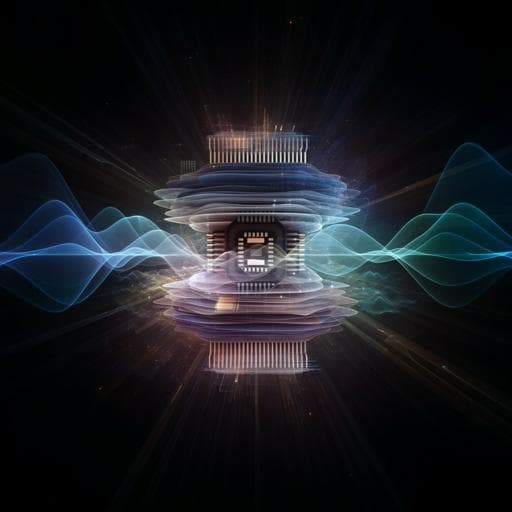
Engineering and Technology
Rapid sensing of hidden objects and defects using a single-pixel diffractive terahertz sensor
J. Li, X. Li, et al.
Discover how Jingxi Li and colleagues have developed a groundbreaking diffractive sensor that utilizes terahertz waves for rapid detection of hidden defects in materials. Their innovative approach eliminates the need for tedious sample scanning, offering a game-changing solution for security screening, biomedical sensing, and industrial quality control.
~3 min • Beginner • English
Introduction
The paper addresses the need for non-invasive detection of hidden structures/defects across applications such as security screening, industrial manufacturing/quality control, medicine, construction, and defense. Terahertz (THz) technology is well-suited because THz waves penetrate many optically opaque materials and provide spectral fingerprints. Conventional THz-TDS systems (including reflective variants) are single-pixel and require raster scanning to form images, limiting speed/throughput. Alternatives like nonlinear optical upconversion to NIR cameras suffer from low SNR and bulky, costly lasers; computational ghost imaging with THz spatial light modulators avoids scanning but is constrained by modulator speed, complexity, and cost. THz focal-plane arrays have limited spatial resolution and lack time/frequency-resolved data. Beyond hardware limits, imaging-based pipelines create bottlenecks in storage, transmission, and digital processing, especially when defects are rare. The authors propose a fundamentally different approach: an all-optical diffractive sensor that, without forming images or raster scanning, encodes the presence/absence of hidden 3D structures into a measured output spectrum at a single-pixel detector, enabling rapid, high-throughput defect detection.
Literature Review
Prior work includes THz-TDS for non-destructive inspection providing frequency- and time-resolved responses, but requiring raster scanning. Nonlinear electro-optic upconversion imaging enables camera-based visualization without scanning but demands high-energy lasers and suffers low SNR. THz computational ghost imaging encodes scene information via spatial light modulators and reconstructs images computationally, achieving decent resolution and SNR but limited by modulator constraints (speed, size, cost). Existing THz focal-plane arrays (FETs, microbolometers) offer limited spatial resolution and lack time/frequency-resolved imaging. Collectively, these systems have much lower space-bandwidth product than visible systems, limiting information throughput. Furthermore, in real deployments, image capture, storage, transmission, and GPU-based processing create severe throughput bottlenecks when defects are rare, wasting resources on redundant image data.
Methodology
System architecture: A passive diffractive encoder generates structured broadband THz illumination in the detection field-of-view (FOV), and a diffractive decoder performs a space-to-spectrum transformation. A single-pixel spectroscopic detector at the output aperture samples the output spectrum at two predetermined wavelengths, λ1 and λ2, yielding s(λ1) and s(λ2). The normalized detection score is S_det = s(λ1) / (s(λ1) + s(λ2)); an unbiased decision threshold S_th = 0.5 classifies presence (s(λ1) ≥ s(λ2)) vs absence (s(λ1) < s(λ2)) of hidden defects.
Design specifics: Proof-of-concept targets pore-like defects hidden at the interface of stacked silicon wafers (2×2 cm FOV). Operational wavelengths chosen: λ1 = 0.8 mm and λ2 = 1.1 mm (λ_m = 0.95 mm). The diffractive sensor uses four layers: two before and two after the sample. Each layer has 100×100 trainable phase features with lateral size ~0.5 mm (~0.53λ_m). Physical layout includes 5×5 mm input aperture and 2×2 mm output aperture/detector active area; axial distances are specified in Fig. 2b (noted in text). Diffractive layers are 3D-printed and assembled with a custom holder.
Training data: 20,000 simulated silicon samples with rectangular defects (Dx, Dy ∈ [1, 3] mm; Dz ∈ [0.23, 0.27] mm) placed at random positions within the FOV, plus a defect-free sample replicated to balance classes 1:1 (20,000 positives + 20,000 negatives). A blind test set of 2,000 defective samples used unique parameter combinations not seen during training; one negative sample was also tested. Training is a one-time effort akin to training a digital analyzer.
Forward model: Layers are thin dielectric modulators with complex transmission t_k(x,y,z,λ) = a_k exp(jφ_k); free-space propagation modeled by Rayleigh–Sommerfeld diffraction. Material dispersion n_k(λ), κ_k(λ) measured for the 3D-printed material. Trainable thickness h_trainable ∈ [0, 0.8 mm] plus base thickness h_base = 0.6 mm. Propagation in silicon uses n_object = 3.4174, κ_object = 0 (negligible absorption in band). Defects modeled as air voids (n_defect = 1, κ_defect = 0) introducing amplitude/phase perturbations proportional to defect depth h_defect = Dz.
Detection signal: The detector integrates intensity over its 2×2 mm active area: s(λ) = Σ_(x,y∈D) |E^(K+1)(x,y,z,λ)|^2. S_det computed from s(λ1), s(λ2).
Loss functions: Total loss L_total = L_det + α L_eff + β L_ed. L_det is focal loss with β=0.5 (class balance) and γ=4 (focus on hard samples). L_eff promotes photon efficiency by penalizing low diffraction efficiency η at the detector across λ1, λ2 with threshold η_th = 0.01; η = detector/input power (detector integrates over D, input over P across λ1, λ2). L_ed suppresses spectral power at neighboring wavelengths Λ = {0.75, 0.85, 1.05, 1.15} mm to concentrate energy at λ1, λ2. Weights α_eff = 0.01 and α_ed = 0.1.
Training details: Numerical sampling period 0.25 mm (~0.26λ_m), half the diffractive feature size. Dataset: 24,000 defective samples generated, split into train/val/test as 20,000/2,000/2,000 and balanced with defect-free replicas at 1:1 for each split. Silicon wafer thickness modeled as a random variable uniform in [0.52, 0.53] mm for robustness. Optimizer: Adam (default params), batch size 32, learning rate 0.001, 200 epochs (~10 h) using TensorFlow 2.5 on a GTX 1080Ti and Core i7-8700 with 64 GB RAM; best model chosen via validation.
Fabrication and set-up: Defects fabricated in silicon by LPCVD SiO2, lithography, RIE of SiO2, DRIE of Si (SiO2 mask), BOE removal; measured Dz ≈ 0.25 mm. Diffractive layers printed (Formlabs Form 3) and assembled in a 3D-printed holder (Objet30 Pro). THz-TDS uses a Ti:Sapphire 780 nm, 78 MHz laser; plasmonic photoconductive nano-antenna array source and detector; off-axis parabolic mirrors; detector readout via transimpedance amplifier and lock-in; 320 ps time span yields ~5 THz bandwidth and 90 dB SNR. Calibration normalizes experimental spectra to account for source spectral profile using linear correction derived from defect-free sample peaks near λ1, λ2.
Key Findings
Numerical performance (blind testing):
- With unbiased threshold S_th = 0.5, true positive rate (TPR) = 89.62% on 2,000 defective test samples; defect-free sample correctly identified (specificity 100%, FPR 0%).
- Optimizing threshold to S_th = 0.4989 increased TPR to 90.48% while keeping specificity 100%, but this threshold was too close to S_det(negative) = 0.4988, risking false positives experimentally; thus S_th = 0.5 was selected.
Sensitivity vs defect size and depth:
- Larger defects (Dx = Dy = 3 mm, Dz = 0.3 mm, random positions in FOV): TPR = 100%.
- Small lateral sizes reduce sensitivity: for Dx = Dy = 0.75 mm (< λ1, λ2), TPR drops to 57%.
- Shallower defects reduce sensitivity: for Dx, Dy ∈ [2.5, 3] mm, TPR ≈ 99.7% at Dz = 0.3 mm, dropping to ≈ 81.2% at Dz = 0.15 mm.
- For TPR ≥ 75% criterion, detectable defects down to Dx, Dy ≈ 1.25 mm and Dz ≈ 0.21 mm within a 2×2 cm FOV (feature sizes near diffraction limit in air).
Sensitivity vs position:
- For a small defect Dx = Dy = 0.75 mm, Dz = 0.18 mm, TPR ~100% within central regions R1–R4; TPR ~65% in R5 and ~20% in R6 (edges). Effective high-sensitivity region ~1.6 cm diameter at center.
Experimental validation:
- 10 silicon samples (9 with hidden defects, 1 defect-free), each measured 5 times; experimental spectra agree well with simulations after calibration. Hidden defects include previously unseen shapes and a rotated rectangle.
- Averaging N_avg = 5 measurements per sample improved SNR; using peak intensities near λ1 and λ2 from averaged spectra provided S_det,exp. Histogram of 252 combined averages from 10 repeats of the defect-free sample yielded FPR = 10.7% at N_avg = 5 with S_th = 0.5.
- FPR vs averaging: N_avg = 1 → FPR ~30%; N_avg = 5 → 10.7%; N_avg = 8 → 0% (false positives eliminated by averaging).
Discussion
The presented diffractive THz sensor performs end-to-end, all-optical inference of hidden 3D defects using a single-pixel spectroscopic detector, avoiding image formation, storage, transmission, and GPU-based processing. Its encoder–decoder diffractive architecture jointly trained to perform structured illumination and spatial–spectral encoding enables rapid, high-throughput screening suited to industrial quality control and security applications where defects are rare. Compared to conventional THz imaging (raster-scanned TDS, focal-plane arrays, computational ghost imaging), this approach reduces system complexity and dramatically increases throughput, potentially aligning with single-pixel response times (<1 μs). Numerical analyses reveal strong detection performance for defects near the diffraction limit over a large FOV, with best sensitivity in a central ~1.6 cm diameter region; experiments validate feasibility and robustness with 3D-printed layers and a THz-TDS setup, showing good agreement with simulations and controllable FPR via measurement averaging. The physical insight suggests λ1 acts as a reference (spherical-like illumination) while λ2 acts as a structured probe, with the probe’s intensity distribution influencing S_det across the FOV. The framework is flexible: it can be extended to reflection mode for highly absorbing/reflective samples, scaled to larger FOV with larger diffractive layers and higher NA, improved with deeper diffractive networks, shorter wavelengths for resolving smaller features, or more wavelengths to spectrally encode richer defect attributes (e.g., size, material).
Conclusion
This work introduces a single-pixel diffractive terahertz sensor that encodes the presence of hidden defects within 3D samples into spectral features at two wavelengths, enabling rapid, non-destructive, all-optical detection without image formation or digital processing. The system, comprising jointly trained diffractive encoder–decoder layers, demonstrates high specificity and strong sensitivity in simulations and experimental validation on silicon wafers with hidden defects, including previously unseen shapes and orientations. The approach promises significant throughput gains and reduced cost/complexity for applications in industrial quality control, material inspection, and security screening. Future directions include: scaling the FOV and numerical aperture with larger diffractive layers; increasing network depth; operating at shorter THz wavelengths to enhance sensitivity to smaller features; using more wavelengths to encode and classify additional defect attributes; and implementing reflection-mode architectures to probe highly absorbing or metal-containing samples.
Limitations
- Transmission-mode penetration is limited by THz absorption/scattering in samples; highly absorbing or metal-core objects reduce SNR and depth reach (reflection-mode adaptation proposed).
- Performance degrades toward FOV edges due to training representation and structured illumination profile; best sensitivity in central ~1.6 cm diameter region.
- Mechanical misalignments among diffractive layers and between layers and sample, as well as fabrication inaccuracies and refractive index errors, can reduce performance; mitigation via misalignment- and error-tolerant training (“vaccination”) is suggested.
- Experimental false positives can occur without sufficient averaging; FPR ~30% at N_avg=1, ~10.7% at N_avg=5, eliminated at N_avg=8 in reported tests.
- Current implementation uses only two wavelengths, not leveraging full TDS bandwidth; more wavelengths would require more trainable features and complexity.
- Diffraction-limited sensing: isolated subwavelength defects may be detectable via scattering into propagating waves, but multiple closely spaced subwavelength defects cannot be resolved or morphologically distinguished without near-field information.
Related Publications
Explore these studies to deepen your understanding of the subject.







